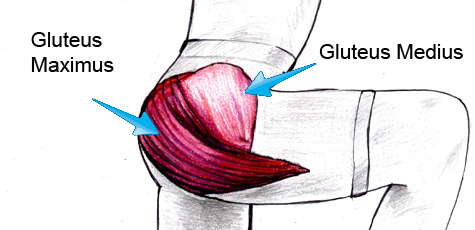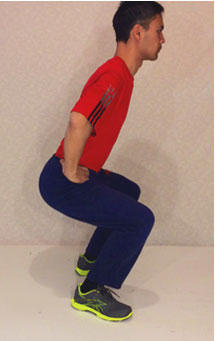2 simple gluteus muscle tests to relieve your back pain
By Sherwin Nicholson | May 4, 2020

Your Gluteus maximus muscle is the KEY to preventing lower back pain.
Do you have both glute muscle pain, hip and back problems? It’s not a coincidence.
When your maximus is well conditioned, it will be the first muscle to activate upon leg muscle contraction. This is very important because you need it every time for raising your body up, moving it forward and for lowering it down.
When your glutes are in charge, your back and hips won’t hurt you.
Other muscles, such as your quadriceps (thighs) are important, but without the glutes, the legs, hips, knees and ultimately your lower back ends up suffering.
Here is the one thing your must take from this article:
You must use your maximus, so your back and knees won’t hurt.
Outlined below are 2 simple tests to prove if they are the cause of your pain.
If you have trouble with these tests, you must begin conditioning yourself now. These muscles are never something to neglect and you’ll feel it. If you find your legs, knees or spine feeling sore for even a short period, then weak and inactive glutes are the reason.
Follow Test One Now
The Squat Test
With loose fitting and comfortable clothing,
- Stand with legs shoulder width apart
- Lower yourself slowly into a squat position. A half squat or a full squat is preferred
- Either raise your arms in front or you or place them on your waist
- Hold this position
- While holding, determine which muscles are the first to become sore
- Time your hold
- Stand up, rest

Can you hold this pose for long? The longer, the better.
What are you feeling?
Are your glutes activating as they should? Do you feel them first?
They should be providing most of your lifting and holding power. Not your Quadriceps. There should be NO knee discomfort.
If you find that your quadriceps, knees and lower back becomes sore long before your glutes do, you have found your problem. You must condition them. Everything else is working too hard to support you.
Ideally, anyone should be able to hold the squat position for several minutes or more without ANY effort. The only discomfort should be when your glutes naturally tire and no where else.
This test shows just how much we need to rely on the muscles of our behind to remain stable in this position and pain free.
Follow Test Two
The Lunge Test
With loose fitting clothing and non-slippery footwear,
- Stand with legs shoulder width apart
- Lower yourself into the squat test
- Put both hands on your hips
- Step backwards with one leg, one full step (do not move the other leg)
- Lower your body and low as possible until the forward thigh is horizontal with the floor
- Do not rest the knee of your stepping leg on the ground
- Hold this position
- While holding this position, determine which muscles become sore
- Determine if your pelvis or hips drop to one side
- Time your hold
- Stand up, rest

If this pose make you unstable, you need to master it to save your back.
Note: These exercises will test whether or not you have the flexibility, strength and endurance in your lower legs needed to prevent pain.
How easy was it for you?
Did it hurt? Where you balanced or stable?
If you felt sore and unsure of your stability, you have found your problem again.
This exercise is to test the strength, endurance and balance of both leg muscles. It’s more difficult than the squat test so you might become more tired doing it. If you have lumbar spine problems, you may find it difficult keeping both sides of your hip level with the ground. One may fall lower than the other.
You may find your quadriceps becoming sore faster than your glutes do along with knee pain.
What you should be doing
If you can perform this exercise easily for over 30 seconds, then you are protected. If you are struggling to maintain this hold or that you are unbalanced, you need to retrain and recondition your lower body.
The key to overcoming the pain in the majority of cases is by treating muscle weaknesses and imbalances. The Squat Test and The Lunge Test can reveal this problem for you.
When you’re ready to strengthen your glutes the right way through the 4 stage Program, you will not only use these “Test” exercises to identify your weakness, but also to move as your body naturally should.
If you know that you cannot pass the Squat Test and Lunge Test and need help, download this guide to help you. It has helped thousands of people who were in need of a program to get themselves pain free.
“The book goes in depth on the dynamics of back movements and has in detailed exercise instructions.”
For even more help:
Try these exercises for your glutes
Activate your butt muscles everytime you do this
More tips to help you find relief
References:
- Framework for the Lower Back – Nicholas DiNubile, MD. 2009. Rodale Books Inc. 617.564
- www.mayoclinic.com
- Exercise, not to exercise, or how to exercise in patients with chronic pain? Applying science to practice.-http://www.ncbi.nlm.nih.gov/pubmed/24662498
